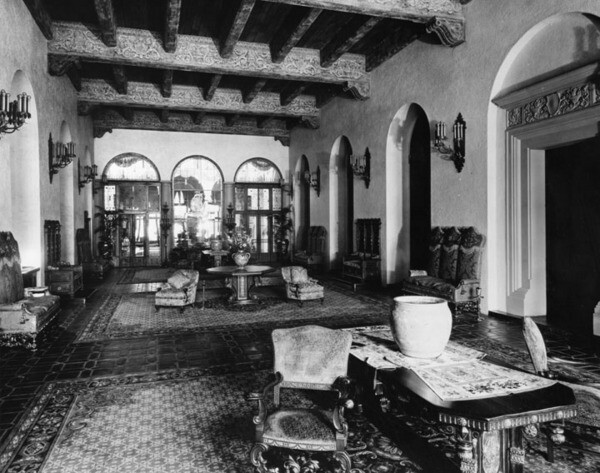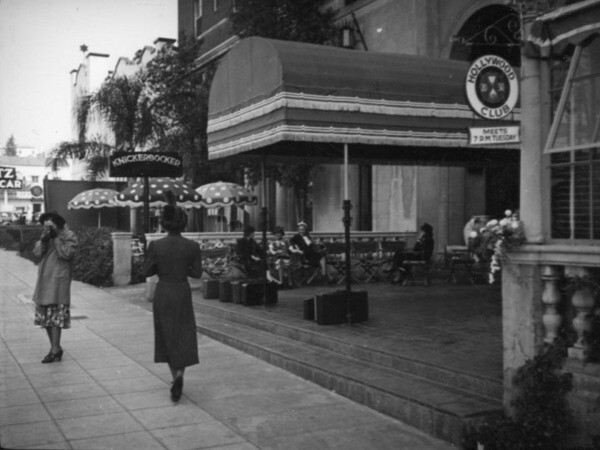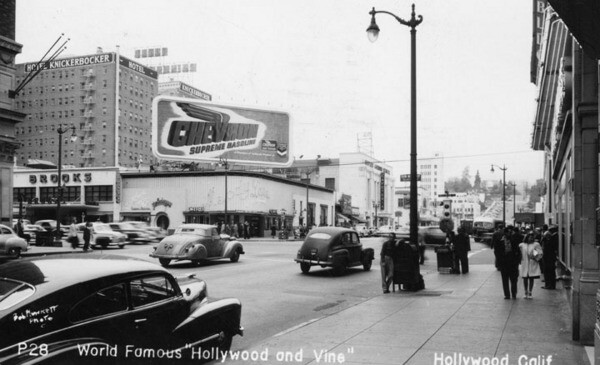Off the Boulevard of Broken Dreams: The Knickerbocker Hotel's Haunted History

I stepped onto the 1700 block of Ivar Avenue on an overcast Sunday afternoon. One block over, across Hollywood Boulevard, the farmers and craftspeople of the Hollywood Famers Market were packing their produce into trucks and vans, as straggling hipsters scrambled to buy one more perfect peach or lavender bundle. But on this side of the street, it was almost deserted, with ample parking and shuttered storefronts. At first glance, the whitewashed Knickerbocker Apartments looks like a thousand other low income apartment buildings for senior citizens in Los Angeles. The famous neon sign on the roof, advertising the Knickerbocker in block letters, was turned off. In front of the building, an elderly woman spoke rapid Russian into a cell phone as she looked frantically down the street, clearly waiting for a ride. A peek into the faded lobby revealed nothing remarkable except an elaborate chandelier, entirely too glamorous for its grim surroundings.
No matter how hard you look, there is nothing very remarkable about the Knickerbocker today. On one side of the building is some kind of Russian Banquet Hall, and the day I was there three young men huddled at the entrance, smoking while engaged in weary conversation. There are a couple of businesses -- including a hair salon straight out of the 80s -- that look like they are never open. The building itself appears tired and worn out -- and really who can blame it. For the Knickerbocker's history has been as jammed packed and traumatic as any melodrama made by the city that it calls home.



Height-limit Hollywood
Two days of festivities will mark the opening of the Hollywood Knickerbocker Apartments, the film capital's largest apartment-hotel, rising eleven stories on Ivar Avenue near Hollywood Blvd.... Notables of filmdom, the stage and society have been invited to assemble Wednesday for an informal preview. Heralding the event will be an electrical display. A buffet supper will be served and a deluxe program rendered by a symphony orchestrette and troubadours playing in the foyers, promenades, loungers and The Lido -- the Venetian open air patio. For the benefit of the public, on Thursday, the official opening will be staged...The entire structure from the basement garage to the elaborate suites on the eleventh floor will be opened for inspection, with members of the staff of 100 employees of the Knickerbocker to conduct the visitors through the hostelry.--Los Angeles Times, July 14, 1929 1
In 1905, the first mayor of Hollywood had signed an ordinance that prohibited driving herds of more than 800 sheep down sleepy Hollywood Boulevard. By the late 1920s, the street had come a long way from the rural, upper-class country road of a scant two decades before: it was a vibrant cosmopolitan center, boasting an increasing number of "height-limit" (eleven story) "skyscrapers" featuring scandalous clubs, swanky apartments, and grandiose picture palaces. In July 1929, another skyscraper was added to the skyline when the Hollywood Knickerbocker Hotel opened at 1714 Ivar Avenue. The luxe Spanish-Colonial building and its nightclub, the Lido Room, immediately became a hotspot for travelling aristocrats and folks from the burgeoning film community.

During the 1930s, the hotel was bustling with activity straight out of a screwball comedy. Stars like Maureen O'Sullivan lived in long term apartments at the hotel. On any given day, there might be an interview taking place in one of the rooms with Mrs. Elinor Mordaunt, a British authoress pleasantly surprised by the charm of Hollywood, while members of the Vine Street Development Association, including Louis B. Mayer and Howard Hughes, were toasting their success in the banquet room. Scotch Balladeers, Russian dancers, and string quartets performed in the Lido Room and on the large patio. There were wedding breakfasts for minor film stars, and evening banquets for the Athletic Conference of American College Women. Betty Grable hosted a "high jinx" filled costume party to celebrate child star Jackie Coogan's 21st birthday, which included Lucille Ball dressed as one of the Dionne quintuplets and Johnny Mercer providing impromptu entertainment on the piano. One peculiar event was strictly for the dogs:
Scenarist Al Martin is responsible for the episode which took place Friday night, in the Lido Room of the Knickerbocker Hotel. In honor of his dog, Al gave a party. To the affair were invited...Joan Crawford...Mervyn LeRoy...this list of notables however, were not the guests. They were merely bidden to bring their dogs, who were the guests of Mr. Martin's pooch! All the chaperones were requested to wear evening clothes for their dinners and Al had two ambulances from animal hospitals waiting at the door in case one pet coveted too much another's special bowl of rations. 2
During the 1932 Olympics the hotel was home to gala events for both the Danish and Indian delegations. M.C. Dhawn was one of the Indian athletes who stayed at the hotel during the games. As a child he had been inspired to become an athlete after watching the agile feats of silent star Douglas Fairbanks. One can only hope he was at this event written up breathlessly by the L.A. Times:
You can see where a Hindustani Olympic tea, with such stylish patrons as Doug [Fairbanks] and Mary [Pickford], the C.B. DeMilles...etc.... could be pretty swanky, so the Knickerbocker Hotel was a gala scene. Lal Chandra Mehra, in full Hindustani regalia, was really the host deluxe, in a white and gold embroidered turban and costume to match. Mrs. Mary Watts was a charming personage in her rose pink sari...the genuine Indian curry served was made by Lal Chandra Mehra himself, who also pinch hit for the sword swallower. 3
In 1935, the macabre came to the Knickerbocker (and really never left) when the Pacific Coast Association of Magicians held their third annual convention at the hotel. Bess Houdini, a magician and the widow of the legendary Harry Houdini, attended the convention. Bystanders at the hotel and in Hollywood were privy to the magicians' high jinx:
Among the free thrills planned for the public today by the visitors are an automobile race on Hollywood Boulevard with blindfolded drivers at the wheels at 12:30 p.m., and an escape from a strait jacket by a magician while hanging upside down outside the convention hotel. 4
A year later, on October 31, 1936, an event occurred which would seal the Knickerbocker's legendary status. Before he passed away on Halloween 1926, Harry Houdini had told Bess that if he died and there was an afterlife, he would come back to her to prove it once and for all. For ten years Bess had been holding a séance every Halloween, waiting for Harry to give her a sign. The last séance, conducted on the roof of the Knickerbocker, was a media sensation. A young L.A. Times reporter named Gene Sherman recalled being sent to cover the story:
A jury of highly reputable witnesses, including superior judge Charles Fricke was on hand. The séance itself was conducted by a gentleman named Edward Saint, a confidant of the magician's widow. It was a dismal, drizzly night. On a red plush carpet stood a table on which rested a spirit trumpet, a bell, a piece of chalk, two slates, a pencil, and a black pad of paper. Mr. Saint urged Mr. Houdini to juggle the table, ring the bell, spring through the trumpet, or do something to manifest his presence. Mrs. Houdini said, "Please Harry, I've been waiting so long." The solemn cadence of "Pomp and Circumstance" drifted through a loudspeaker. The automobile horns of the impatient living honked mournfully below. Nothing happened -- other than an air of eerie tenseness. The meeting broke up and I made my way back to the office where I guiltily admitted I had failed to get the interview. Under the circumstances, I wasn't too much to blame. 5

Hollywood Babylon
I drank all the liquor I could get my hands on, including Benzedrine...What do you expect me to do? I get liquor in my orange juice-in my coffee. Must I starve to death to obey your laws?"--Frances Farmer to a judge, after her arrest at the Knickerbocker 6
After the unsuccessful Houdini séance, stories from the Knickerbocker seem to shift from screwball to a darker shade of film noir. The beautiful, mentally ill actress Frances Farmer, now the legendary archetype of Hollywood's tragic underbelly, lived at the hotel, drinking herself into oblivion. In 1943, police knocked on her door at noon, a warrant for unpaid DUI fines in hand. They eventually opened the door with a passkey, where they found Farmer naked and in the middle of a drunken, manic episode. She refused to cooperate with the cops, clawing and scratching. Eventually she was wrapped in her own shower curtain and carried through the hotel kicking, spitting, and screaming. In one reporter's words: "She did not surrender peacefully." 7
Most of the action at the Knickerbocker was witnessed by Speck, the beloved English setter of hotel manager Jack Matthews. Speck could often be seen ringing his master's doorbell, and almost unbelievably, was said to be able to use the elevators on his own- pushing the elevator button with his paw. He always let hotel guests enter and exit first. 8
During the war, a group of pioneering United Airline stewardesses called the Knickerbocker home in between flights that often involved the military's war effort:
There is a cosmopolitan atmosphere about the girls' arrivals and departures as they whisk into town and out again to the airport, but in the apartment it is more like a sorority house. They relax, play the radio or take a sunbath on the sundeck of the hotel. Some of the girls prefer to eat in the apartment rather than go out to a restaurant, so a little domesticity appears as they don aprons and prepare meals. There's lots of chatter about where they have been and funny experiences they've had. But the "do not talk" slogan of all airlines is observed strictly by these girls on military subjects. 9

Countless guests and residents at the hotel no doubt unknowingly walked by a lost looking, elegant old gentleman swinging his signature cane through the lobby. This man, who was in large part responsible for the birth of "Hollywood," was pioneering director D.W. Griffith. During the last year of his life, the forgotten, out of work Griffith lived an "exceedingly quiet life" in his room at the Knickerbocker, spending most of his time alone with his books and papers. In the early evenings, Griffith would wander up and down Hollywood Boulevard unrecognized, often weaving in and out of multiple bars. Screenwriter Frances Marion recalled a heartbreaking scene at a handprint ceremony at Grauman's Chinese Theater, when she spotted a bewildered, stooped Griffith "hovering at the edge of the crowd." Unbelievably, he had never been asked for his handprints. On July 23, 1948, he suffered a massive stroke in his room at the hotel. He died later that day.
As the '40s turned into the '50s, Hollywood became less and less trendy, as celebrities and society moved increasingly toward west L.A. However, as the Knickerbocker's cachet faded, it increasingly became an out of the way rendezvous spot for famous folks craving privacy. Ill-fated lovers Marilyn Monroe and Joe DiMaggio would often meet in the hotel bar for incognito dates. In January 1954, it is claimed they spent their honeymoon in the hotel. That same year, legendary architect Paul R. Williams oversaw the hotel's renovation. Elvis Presley spent time in a newly renovated room in 1956, when producer Hal Wallace brought him to Hollywood to star in "Love Me Tender."
Heartbreak Hotel
I am sorry to do this in this manner. Please see that [my husband] Eliot is taken care of. Alden take over the business. Get someone very good to design and be happy. I love you all. Irene--Los Angeles Times, Nov 16, 1962 10
By 1962, the faded Knickerbocker was no longer a sexy place to hide, but people still hid out there. That year a sophisticated middle-aged woman checked into the Knickerbocker under an assumed name. Her real name was Irene Gibbons, though professionally she went by a single name -- Irene. During the golden age of Hollywood she had been a celebrated costume designer, dressing stars like Ingrid Bergman, Marlene Dietrich, Carole Lombard, and her great friend Joan Crawford. After retiring from film work she had started her own boutique, and continued to dress many of her famous friends. A week before her arrival at the Knickerbocker she had shown her new collection at the California Fashion Show in Beverly Hills, telling one reporter, "Anything new and beautiful makes one think beautiful thoughts!"

But Irene's thoughts were no longer beautiful. Worried about finances, and devastated by her husband's recent stroke and the death of her unrequited love Gary Cooper, she checked into the Knickerbocker. She proceeded to get drunk and write multiple suicide notes, including one to fellow hotel guests that read, "Sorry I had to drink so much to get the courage to do this." She then slit her wrists. At 3:20 p.m., still not dead, she jumped to her death from a hotel window. Her body landed on the roof of the hotel lobby.
In 1966, longtime Knickerbocker resident William Frawley, better known as curmudgeonly Fred Mertz from I Love Lucy, suffered a heart attack while walking down Hollywood Boulevard. His nurse dragged him into the hotel's lobby and an ambulance was called. He died at the hospital.
The now dumpy Knickerbocker went through multiple owners, as Hollywood Boulevard became increasingly seedy and unsafe. In 1972, the hotel was converted into senior citizen housing for moderate to low income residents. It is unsurprising that now many ghosts supposedly haunt the Knickerbocker. It is said a beloved bellhop named Roger walks the halls, while Marilyn Monroe stares at herself in the powder room vanity. Many anonymous hotel patrons have been seen. Doors slam on their own. In the most ironic twist, Rudolph Valentino is often sighted, even though he died four years before the Knickerbocker opened. That's Hollywood for you.
_____
1 "Festivities to mark opening of apartments", Los Angeles Times, July 14, 1929
2 "Film notables' canine pet guests of honor", Los Angeles Times, December 29, 1935
3 "Sugar and spice", Los Angeles Times, July 3, 1932
4 "Magicians meet today", Los Angeles Times, July 25, 1935
5 "Cityside with Gene Sherman", Los Angeles Times, October 31, 1956
6 "frances farmer knocks policeman down", Los Angeles Times, January 15, 1943
7 Ibid.
8 "Hotel was historic host to Hollywood" Los Angeles Times, July 26, 1998
9 "Three room home shared by air women", Los Angeles Times, October 25, 1943
10 "Famed dress designer Irene leaps to death", Los Angeles Times, November 16, 1962


